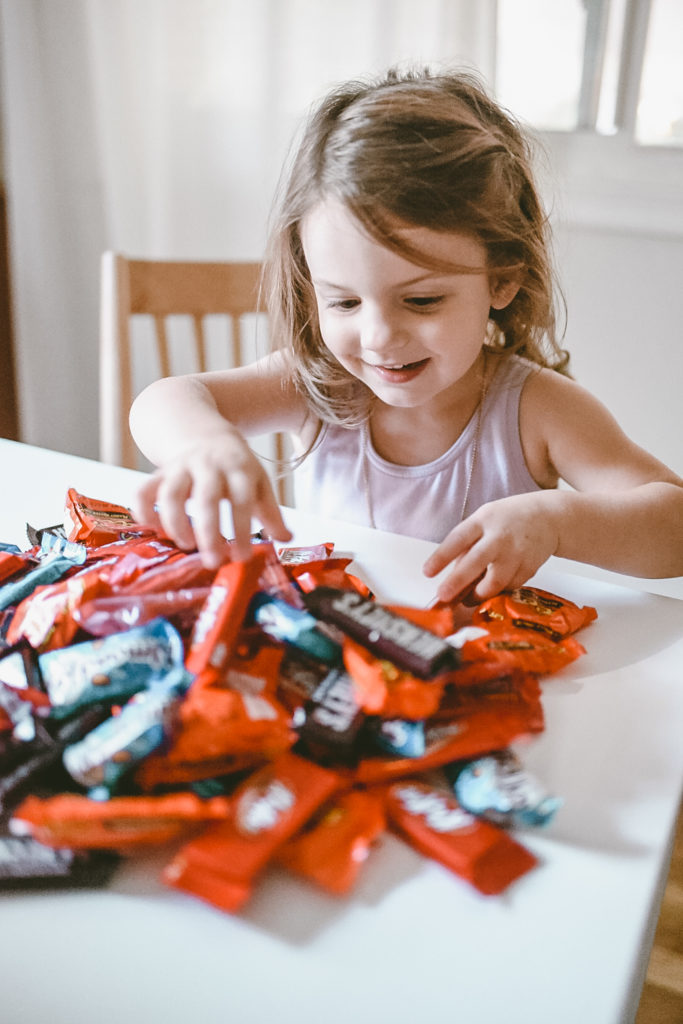Halloween is just around the corner, and with it comes the excitement of costumes, decorations, and yes—lots of candy. Learning Tree parents, I know firsthand that this can bring up all kinds of questions: When should I let my child have candy? How much is okay? Will they be obsessed with it?
As a mom of three, I get it—I’ve had those same thoughts myself. I remember when my oldest was at that stage of wanting all the Halloween candy. I wanted to make sure I handled it in a way that didn’t create food battles or make candy feel like some forbidden treasure. It’s tricky territory! Let’s dive into the when and how of introducing Halloween candy to your little ones, with as little stress as possible!
When Should I Introduce Halloween Candy?
Safety First for Kids Under 4
You’re probably wondering when your child is ready to enjoy candy like the “big kids”. In general, once your child has a full set of baby teeth, which is around 3 years old, then you can start letting them explore candy. When we’re considering foods with added sugar in general, as dietitians we recommend waiting until at least 2 years old. More on this below!
But there are some safety considerations, as some types of candy can be more problematic than others. Hard candies, gum, or chewy, sticky treats (like caramels or taffy) can pose a real choking risk for little ones, especially kids under 4. For this age group, it’s best to stick with candies that dissolve easily, like chocolate, puffed candy, or cotton candy. It’s always a good idea to check the size and texture of the candy and keep an eye on them while they’re eating.
Sugar Guidelines for Toddlers
Now, let’s talk sugar. The reality is that young kids are naturally curious about sweet foods and it’s normal for them to want to taste and explore candy. But it’s also important to keep in mind that babies and toddlers have different nutritional needs. The World Health Organization recommends that children under the age of 2 avoid added sugars altogether, while kids over 2 should keep their intake of added sugars low (around 25 grams or 6 teaspoons per day).
Does this mean no candy at all for little ones? Not necessarily! A small amount in a safe context can be part of a positive mealtime environment and can actually help them develop a positive relationship with sweets long term. It’s all about creating a positive, neutral environment around food, where candy is just another option—one that doesn’t hold too much power but can be enjoyed like anything else.
How to Introduce Candy to Your Child in a Healthy Way
Now that we know the “when”, it’s time to unpack the “how” of introducing candy, which is my all-time favorite topic!
-
Use a Food Neutral Approach
One of the most important things we can do as parents is to avoid labeling candy as “good” or “bad.” When we put certain foods on a pedestal or make them seem off-limits, it has what I like to call the “forbidden fruit” effect.
By keeping candy—and all foods—neutral, we help our children develop a healthy relationship with eating. This means candy isn’t treated as a special reward, nor is it something to feel guilty about. It’s just another type of food that can fit into their world with a variety of other foods.
-
Introduce Candy Alongside Meals or Snacks
Rather than treating candy as a stand-alone treat, try offering it as part of regular meals or snack times. For example, include a small piece of candy alongside a nourishing snack—like fruit and cheese. When candy is presented alongside other foods, it becomes less of a “big deal,” which can prevent obsessing over it.
The bonus? Offering candy alongside nutrient-dense foods also helps to stabilize blood sugar levels. When candy is eaten on its own, the simple sugars can cause a quick spike in blood sugar, followed by an energy crash. Pairing candy with sources of protein, fat, or fiber slows down the absorption of sugar, helping to maintain steadier energy levels. This strategy also keeps little tummies more satisfied for longer.
What if My Child Becomes “Obsessed” with Candy?
It’s common for parents to worry that introducing candy will lead to their child becoming fixated on sweets (here’s what to do if you notice your child sneaking candy, by the way). But here’s the thing: allowing some flexibility and openness with candy can actually reduce the fascination over time. When we make certain foods feel off-limits or special, it only heightens kids’ curiosity and desire for them.
I’ve written more extensively about this for the Learning Tree blog, How Halloween Candy Can Help Foster a Healthy Relationship with Food, where I dive into how candy can actually be a learning opportunity for children to develop a positive relationship with food. I’ve also shared my top tips for managing candy before, during and after Halloween, so be sure to check that out, too.

